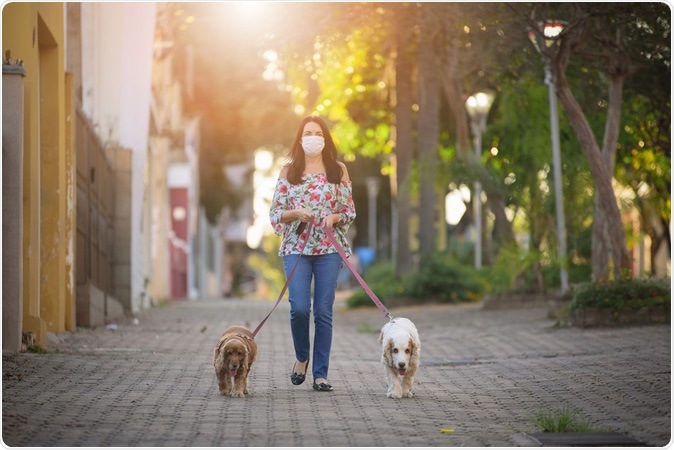COVID-19 in cats and dogs is likely acquired directly from infected humans
by Dr. Tomislav Meštrović, MD, Ph.D.A recent study from Japan available reveals how almost all cases of coronavirus disease (COVID-19) among domestic animals can be linked to their owners infected with the severe acute respiratory syndrome coronavirus 2 (SARS-CoV-2).
The current COVID-19 pandemic, caused by SARS-CoV-2, generated significant disruptions around the world. Although the primary mode of disease transmission is from person to person, the virus has been detected in cats, dogs, and ferrets – raising concerns of possible transmission from, to, or between domestic animals.

Study: Rising evidence of COVID-19 transmission potential to and between animals: do we need to be concerned? Image Credit: Geraldo Betiol
The purported role of cats and dogs
At the end of March 2020, a report came out from Hong Kong indicating that two of nineteen dogs and one of nine cats from households with confirmed human COVID-19 cases (or individuals in close contact with confirmed patients) tested positive for SARS-CoV-2.
Furthermore, a cat from a household in Belgium with a confirmed COVID-19 case was found to be infected. One recent study from Spain also reported the detection of an asymptomatic cat with SARS-CoV-2, probably in close contact with its owner, who was diagnosed with active COVID-19 infection.
At the moment there is no indication that canine-to-human or feline-to-human transmission can ensue, albeit there is rising evidence of the reverse. However, there is still no decisive answer to the question of how pet owners should behave.
Consequently, researchers from Hokkaido University, the Japanese Ministry of Health, Labor and Welfare, as well as from Japan Science and Technology Agency, attempted to resolve some of the uncertainty around animal SARS-CoV-2 transmission and quantify the pattern in mathematical terms.
In pursuit of SARS-CoV-2 animal cases
In the study currently available on the medRxiv* preprint server, the researchers retrieved and collated information on confirmed SARS-CoV-2 animal cases from publicly available notifications and follow-up reports in the World Animal Health Information System (WAHIS), published by the World Organization for Animal Health (OIE).
The attained information on infected captive felids at the Bronx Zoo in New York (United States) was additionally corroborated by utilizing press releases from the Wildlife Conservation Society, a global nonprofit organization that basically runs the Bronx Zoo. The ProMED mailing list of the International Society for Infectious Diseases was also scanned.
"In our modeling framework for the possible sustained chain of transmission among domestic and stray cats in Wuhan, China, we assumed homogeneous mixing and a random independent sampling process in the collection of the serological samples," study authors further explain their approach.
They have employed a formula on the final size of the outbreak to estimate the basic reproduction number. It has to be noted that the derived probability of a major outbreak relies heavily on the presumption that the infectious period behaves as an exponential distribution.
COVID-19 positive owners infecting their pets
A total of seventeen case reports describing confirmed SARS-CoV-2 animal infections were aggregated as of May 15, 2020. Full recovery was noted in all but two animals, while symptoms were rather mild and respiratory or digestive in nature.
Moreover, all cases among domestic animals (except one) were linked to households with SARS-CoV-2 infected owners. The only unconnected case was a cat from New York who lived in a 'healthy household,' but was permitted to walk outside, which means that the infection could have been contracted somewhere in the neighborhood.
Following their modeling framework, the authors estimated the basic reproduction number at 1.09, which implied the probability of a major outbreak at around 7.9%. Taking into account such low probability, the prospect of sustained transmission occurring among domestic and stray cats in Wuhan (China) can be considered low.
"The secondary attack rate of SARS-CoV-2 from human to pets appears to be low and may also be driven by the infectiousness profile of their owners", emphasize study authors.
Implications of study findings
"In conclusion, the current evidence supports the advice of veterinary authorities worldwide that the pet owners and other persons with COVID-19 in close contact with animals should pay special attention to the way they interact with them", caution study authors.
Their data points towards the assumption that the virus is minimally transmissible to and among domestic animals, while all sporadic detections are most likely to be only weakly positive.
Hence, a likely source of the majority of infections in domestic cats and dogs are infected humans. Simultaneously, growing scientific evidence continues to imply a low probability of SARS-CoV-2 transmission from domestic animals to humans.
As of May 2020, the World Health Organization (WHO) reports no evidence that dogs or cats can disseminate SARS-CoV-2 and, hence, act as a source of human infection. This means that there are no valid grounds to remove pets from homes with COVID-19-positive household members.
*Important Notice
medRxiv publishes preliminary scientific reports that are not peer-reviewed and, therefore, should not be regarded as conclusive, guide clinical practice/health-related behavior, or treated as established information.
Journal reference:
- Akhmetzhanov, A.R., Linton, N.M. & Nishiura, H. (2020). Rising evidence of COVID-19 transmission potential to and between animals: do we need to be concerned? medRxiv. https://doi.org/10.1101/2020.05.21.20109041.